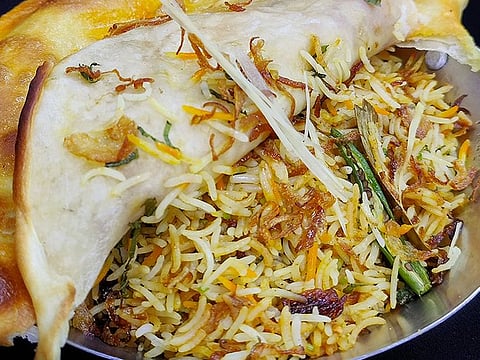Make the royal Awadhi Gosht Biryani at home…
Slow-cooked on fire, with subtle spices and marinated mutton

Dubai: Biryanis taste delicious, depending on who makes them. Cooking biryani is a skill that needs to be mastered with patience, for the love of this dish. Luckily for the Awadhs (the royals in the north of India during the 18th and 19th centuries), their 'Rakabdars' (royal cooks) did a splendid job preparing a dish whose recipe is relished even today – Awadhi Gosht Biryani.
This biryani is mildly spiced and uses a unique cooking style - dum (to slow cook on fire in a sealed container). According to an article titled The royal flavours of Awadh, published in The Hindu, an Indian newspaper, the Awadhs introduced the dum style of cooking to India. In a book titled 'Dastarkhwan – e –Awadh, The Cuisine of Awadh’ by Sangeeta Bhatnagar and R.K Saxena, they write about the many layers of the royal cuisine. The layers being - nafaasat (refinement) and nazaakat (delicateness), a cooking style achieved through the subtle blending of spices, slow fire cooking, and its use of seasonal ingredients.
India's diversity – of cultures and food represents its culinary heritage. Take, for example, the variety of regional Indian biryanis. They all taste different because their ingredients and cooking methods differ. Some recipes are passed on from generation to generation, while others are adapted to suit contemporary taste buds. It so happens that everyone has a favourite biryani recipe or a version they like.
Here is a recipe for Awadhi Gosht biryani
Chef Ayaz Qureshi, of Dubai's Ashiana restaurant, uses a unique ingredient in this recipe that might not be a staple in many Indian kitchens. He adds yellow chilli powder, made using handpicked yellow chillies. The powder can be found in supermarkets or brought from artisanal spice makers.
Preparation time: 2 hours, including marination
Cooking time: 45 minutes
Serves: 2
Ingredients
250 gms long-grained basmati rice or 1 cup
250 gms mutton leg boneless (the pieces are called nukti)
80 gms onions, sliced lengthwise
5 gms blades of mace
10 gms black cardamom or 1 tsp
5 gms green cardamom ½ tsp
5 gms star anise or 1 piece
5 gms bay leaves or 2 leaves
30 gms ghee or clarified butter or 3 tbsp
20 gms mint leaves 1 tsp
10 gms yellow chilli powder (store brought) or 1 tsp
15 gms turmeric or 2 tsp
15 gms ginger, chopped
15 gms garlic, chopped
25 gms salt or according to taste
8 gms cashew nuts, 6 to 8 pieces
10 gms green chillies or 2
5 ml rose water or ½ tsp
5 ml kewra water or ½ tsp
8 to 10 saffron strands
250 ml cream
Method:
1. Wash the rice and soak it in water for about an hour.
Marinate the mutton: Clean the mutton under running water, and rub it with ginger-garlic paste, chilli powder and turmeric powder. Refrigerate it for an hour.
2. In the meantime, in a pan, heat ghee, add sliced onions, and all the whole spices. Once the onion turns golden, add ginger and garlic paste, mutton and sauté.
3. Then add salt, yellow chilli powder and turmeric powder. Cook the mutton for about 2 to 3 minutes on medium heat.
4. Cover with a lid or seal using a silver foil and cook on slow flame for about 30 minutes.
Note: You can also cook the mutton separately in a pressure cooker for 2 to 3 whistles if you are short of time. Ideally, the slow-cooked way is best to get the most out of the spices.
5. Once the mutton is cooked, strain the gravy, add cream, cover it and keep it aside.
6. In a separate cooking pot, boil rice with salt. Cook the rice until it is 70 per cent done, and drain the excess water.
7. Now layer the rice with cooked mutton, drizzle saffron milk, and sprinkle rose and kewra water.
Note: For the saffron milk - simmer milk, add saffron strands to it so that the aroma and colour are released.
8. Garnish with mint leaves and fried cashew nuts, and cook the biryani, sealed with a silver foil, on a slow flame for another 15 minutes.
Note: In a small pan, fry the cashew nuts in ghee or clarified butter for a few seconds until they turn golden.
Serve Awadhi gosht biryani with raita or yoghurt-based spiced condiment.
Sign up for the Daily Briefing
Get the latest news and updates straight to your inbox





